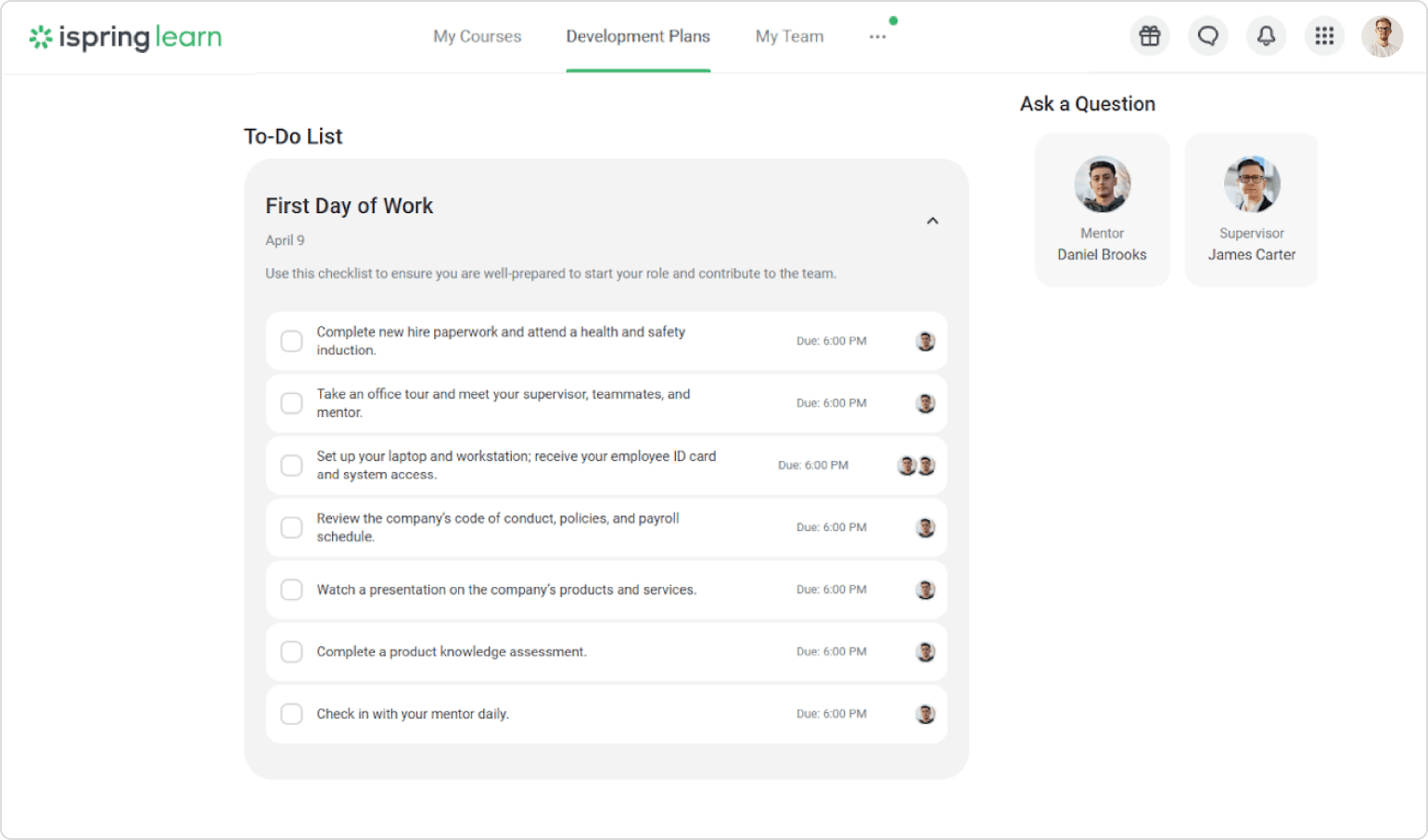Enhance Continuous Skill Development Through an LMS
What are the key factors that foster employee engagement and loyalty within an organization? While competitive salaries and perks certainly play a role, employees equally value opportunities for professional growth. A robust development program demonstrates your commitment to investing in your team, ultimately boosting productivity and job satisfaction.
Despite the importance of ongoing learning, many organizations still find it challenging to implement effective development initiatives. Often, resources are fragmented, poorly organized, and misaligned with employees’ career aspirations.
The new Development Plans module in the iSpring Learn LMS is designed to streamline employee development, making it more efficient and scalable. Follow this step-by-step guide to swiftly build an effective employee development plan.
Transitioning Employee Development Online
Taking employee development online is not merely a trend; it is a strategic and scalable answer to contemporary workplace challenges. In hybrid work settings, traditional training approaches often fall short, with employees juggling tight schedules and remote work dynamics. Quarterly workshops and generic online courses fail to meet employees’ diverse learning preferences.
An LMS enables a flexible and accessible development experience, empowering employees to grow without the disruptions of their busy agendas.
Tackling Real-World Challenges to Boost Productivity
Consider a new employee embarking on their onboarding journey or someone who has just been promoted. They are adapting to new roles and responsibilities and need immediate support rather than waiting for a workshop next month. Online development programs provide:
- On-demand access to learning materials
- Relevant topics tailored to their current role
- Flexible pacing that accommodates work demands
The variety of learning formats available in modern LMS platforms enhances knowledge retention and engagement.
Offering Data-Driven Insights Without Micromanagement
An effective LMS allows for monitoring training progress discreetly, ensuring employees don’t feel overseen. You can:
- Track engagement levels with the material
- Identify employees who may need additional support
- Make informed decisions based on data
Minimizing Onboarding and Training Costs
Investing in employee upskilling can become costly, encompassing print materials, venue rentals, and trainer fees. Transitioning to online development can eliminate many of these expenses without compromising quality:
- Create once, utilize multiple times. Develop a comprehensive onboarding or upskilling course in your LMS and repurpose it for each new hire, updating it as necessary.
- Eliminate the need for constant live sessions. With recorded lessons, self-administered modules, and online assessments, employees can progress independently.
- Reduce logistical burdens. Forget about booking meeting rooms, covering travel expenses, or printing extensive materials for multiple trainees.
Development Plans in iSpring Learn: Simplified Skill Growth Support
When initiating your professional support initiatives through an LMS, select a platform that not only delivers content but also structures, tracks, and personalizes employee growth over time.
iSpring Learn does just that. With its new Employee Development module, it enables efficient, structured, and scalable online training and skill advancement. Create and manage diverse initiatives including:
- Onboarding programs
- Internships
- Custom skill-building roadmaps
- Ongoing professional development paths
To ensure effectiveness, consider integrating:
- Custom checklists with actionable tasks for employees at every milestone
- Mentorship options for additional guidance and feedback
- Detailed progress reports for sharing with trainees and leadership
- Flexible templates adaptable to various roles and skill levels

An example of an onboarding checklist in Development Plans.
With all these features centralized, iSpring Learn enables the transformation of disorganized development strategies into structured processes.
Steps to Create an Effective Development Plan in iSpring Learn
Designing and initiating an employee development plan in iSpring Learn is straightforward:
- Create and assign a new plan. Upload your existing training materials and organize them within the Development Plans module.
- Design a plan template. Tailor one or more templates for different roles and adjust them to fit specific employee needs.
Here’s how to bring your new plan to life:
- Select Development Plans from the LMS sidebar. Choose Assigned Plans and click on Create Development Plan.
- Enter general information and navigate to the Employees tab to select trainees and their mentors. Utilize filters for easy identification.
- Assign a mentor or buddy easily by searching for them by name or title.
- Incorporate checklists that break down tasks into manageable steps. Open the Checklist tab, select From Scratch or From Template, and set due dates.
- Add personalized messages for employees and customize your checklists to enhance engagement.
Monitoring Skill Development Progress Effectively
iSpring Learn’s Team Development dashboard provides an insightful view into how employees are advancing through their development plans. Track completed tasks, missed deadlines, and overall completion rates effortlessly.
Enhance your analytics with these strategies:
- Analyze broader trends in completion. Rather than just identifying missed deadlines, detect if particular tasks face delays, signaling areas for improvement.
- Engage with overdue tasks. Use overdue instances to check in with employees, showing your commitment to their growth.
- Identify team-wide patterns. If multiple employees face the same challenges, consider updating your materials or expectations.
- Regularly communicate insights with leadership. Use dashboard analytics to report overall team growth and areas where further investment might be needed.
By leveraging training analytics, organizations can make informed decisions regarding promotions, role adaptations, and additional support where necessary.
Conclusion
Successful development programs guide and adapt to meet employees’ evolving needs. With iSpring Learn’s Employee Development module, you can move beyond conventional training and construct clear, role-specific growth pathways that your team will embrace.
Regularly review progress, refine plans based on feedback, and celebrate even the minor achievements along the journey. Collecting feedback from employees is vital—encourage them to rate each checklist item after completion to uncover opportunities for improvement. Continuous development thrives when there’s mutual engagement.




